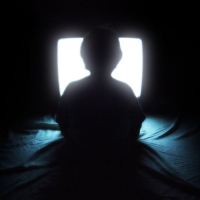
Lie: Passive use of the Internet is harmless, part 3
Truth: Passive use of the Internet is participation in a system of systems designed to create a false and idolatrous reality.
In part 1 of this series, I described the data collection and control system and its components. I did that to give some context for part 2, which outlined the spiritual problem with this system. Now in this part 3, I’ll extend the outline of the problem in terms of how it appears to be rolling out, right under our noses. But before we get to that, let’s revisit a couple of things. What do I mean by ‘passive use?’
By passive use I mean reading, watching or interacting with web content purely at the direction of automated systems. Passive use itself is fundamentally idolatrous because – in that moment – we implicitly and blindly trust a non-human, superior system to guide us, feed us, protect us, and inform us. We passively trust it by virtue of its size, scope, comprehensiveness, speed, accessibility and cultural relevance.
It may include:
- simply surfing the web – mindlessly clicking on news articles, allowing big data/AI systems to determine the scope and content of what you read, watch or interact with.
- allowing visual/graphic content to seduce you into consuming it.
Also, let’s revisit the complete argument of this series in one paragraph, just to make sure we don’t get lost in the details.
Passive use of the internet leads, ultimately, to a deep idolatry because it is a careless but legal agreement to mindlessly participate in and transfer ourselves (via our data) to a deceptive, god-like, reality-altering, tyrannical, and non-human, alternate-world creating system. This system promises an alternative, digital salvation, but is actually designed to trap us by narrowing our options and, physically, mentally and emotionally impairing us until we become completely dependent on its control systems.
In part 2, I left off with a five-fold description of this idolatrous system of systems.
It:
A is Deceptive
B is Idolatrous
C Falsely promises personal salvation
D Blurs the line between our humanity as individuals and machines, between the real and the fake.
E is Tyrannical
And now, in this part 3, let’s get into one more characteristic of this system of systems:
F It’s all consuming, and alternate-world creating
As crazy and as impossible as that may seem, that apparently is precisely what the world powers are aiming at. That is what I’ll attempt to lay out in this article.
The gateway leading to this new artificial world is none other than the smartphone.
Smartphone – digital dashboard to god playing
It’s no secret that the smartphone has taken the world by storm. Since Apple’s launch of its iPhone in 2007, the world has never looked back. No nation in any corner of the world, in any economy, culture, language, urban, rural, is free of its rule. Even remote and relatively primitive areas with no other infrastructure, now have cellular towers and smartphones.
The smartphone is not only everywhere, it’s also taken up, absorbed, and co-opted more and more of our lives.
Let’s compare some of the basic things that we do, before smartphones and after:
| We humans used to . . . | But now with smartphones we . . . |
| write letters (using stamps to mail them) | check email |
| shop in stores | browse Amazon |
| converse in person | use FaceTime |
| do research in libraries | do keyword searches in Google |
| go to the library | ‘check out’ books online |
| take pictures with cameras | take selfies and post to Instagram |
| read books | download podcasts/watch YouTube |
| scrap book/photo albums | post to Facebook/Instagram |
| pay with cash | use PayPal/Bitcoin/credit card |
| go to banks | do online banking |
| pay bills | check automatic bank account drafts on the bank app |
| play board games/card games | play Angry Birds, Fortnight, Minecraft |
| go grocery shopping | get groceries delivered by Instacart |
| use a road map | use GPS |
| have intimate, dinner conversation | talk casually while showing each other pics |
| see a doctor | use telemedicine |
| talk to neighbors | use Facebook or NextDoor app |
| play records/stereo/radio | use Spotify |
| talk on the phone | use SMS text messaging |
| go to the movies | watch YouTube and NetFlix |
| use a flashlight | use the ‘flashlight’ app on the smartphone |
| join a business networking group | use Linkedin |
Just to be clear I’m not saying that this means we should go back to ‘the good ol’ days.’ No. The point is that we need to wake up and recognize what this monopolization by smartphone means.
People increasingly look at their smartphone screens to the point that, doing so, fundamentally characterizes their lives. Young children see their parents as ‘those who look at their phone.’ They cannot imagine their parents without their phone. Shopping means, looking at the phone; conversing means looking at the phone; reading, gaming, research, etc – all reduced, at least to the child, to looking at the phone. The phone now becomes inextricably linked to the mother or father. It effectively becomes part of their hand, their elbow permanently pointed down, their neck bent.
The smartphone single-handedly reduces life to one dimension – the consumption of images. It becomes the three-inch by five-inch digital overlay of our real life. This artificial reality increasingly crowds out the God-given real world and any alternative way.
I start with the smartphone because it is and will continue to be for some time, the primary way that the average person encounters pervasive idolatry. As we rely on the smartphone to handle more and more of our day-to-day activities, it collects more data on us, to the point that it builds a predictive model of you – what you do, where you go, who you talk to, what you talk about, etc, etc. It becomes in effect, your perfect, personal assistant, an idealized digital form of you, able to guide you along life’s path. We effectively transfer ourselves to it – it becomes part of us and we become part of it.
You see where this is headed, right? Is it really that difficult to discern? This ‘personal assistant,’ who possesses practical omniscience – a god-like knowledge and awareness of you and the world – becomes in effect the projected god that you listen to and follow. This is idolatry, which is why we must resist it. And to resist it we must be aware of it and acknowledge it.
How reality is being transmuted into a false world
It may seem far-fetched that our entire world is being transmuted – completely transformed, but look how far we’ve come in the relatively short last one hundred years.
Evil powers are intent on building their own ‘new creation’ – a false, yet immersive, counterfeit creation, and one that challenges and seeks to methodically and incrementally drive out God’s new creation. Let’s go through the stages that it will take to build a fake world that is sufficiently believable. I count at least six:
1 The ubiquity of screens. Since the advent of the silent screen in 1895, to the ‘talkies’ in the 1920s, to the television in the 1950s, the sophistication, quality and functionality of moving pictures has steadily advanced. Higher resolutions, flicker rates, colors, controls, moving from strictly social affairs in theatres to the home to complete privacy, screens have steadily progressed, until now they have become highly-individualized and powerfully-transformative experiences. Although they’ve become familiar, they nonetheless are powerful; we just don’t fully understand how powerful they really are.
But we all knew that TV was not to be the ultimate in moving pictures. In 1984 Apple introduced the Macintosh personal computer and suddenly a new kind of screen was born. About the same time, the first generation of mobile phones hit the market, spawning still another kind of screen. Game consoles came around and then in 2007 Apple introduced the iPhone, and the smartphone was born. Then, the most-recent mass-market screen to arrive was the rudimentary robot, released in 2016, and euphemistically described as a ‘smart speaker.’ Amazon released its Echo Look, its first smart speaker with screen in April 2017.
So I count eight then – eight distinct screen devices and all of them continue in some form: movies, TV, computers, tablets, mobile (basic) phones, game consoles, smartphones and smart speakers (robots). We are now surrounded by screens, one of which is our preferred personal screen (the smartphone). You’re likely even reading this from that screen.
One more screen is worth mentioning. YouTube is the screen within a screen, or the screen of all screens. YouTube ranks consistently as the number two trafficked site, eclipsed only by Google.com. That alone should tell us something about the importance of the screen.
The amount of time we pay attention to these screens continues to increase. In 2018 The Nielsen Company – a major media research firm – released its total audience report and blared: US Adults Now Spend Nearly Half a Day Interacting with Media.[1]
According to the first-quarter 2018 Nielson Total Audience Report, nearly half an adults’ [sic] day is dedicated to consuming this content. In fact, American adults spend over 11 hours per day [on average] listening to, watching, reading or generally interacting with media. Behind this surge are the growing use of new platforms, as well as the younger, multicultural generations who leverage them.[2] [emphasis added]
Of all the screens, TV continues to rack up the most time by far, now accounting for an average of over four hours per day of the eleven hours of screen/media time. It’s fair to say that we are surrounded by screens, sometimes multiple screens (watching TV while surfing the web on the smartphone, or tablet anybody?). All of this screen watching warps our sense of reality. The screen eventually becomes our reality.
2 Smart speaker (IoT). Amazon’s Echo and Dot – Alexa-powered devices are fast becoming household fixtures. It’s now estimated that nearly 20% of US adults have access and use a smart speaker.[3] From Voicebot.ai’s Smart Speaker Consumer Adoption Report:
Smart speaker adoption has exceeded all analyst expectation and has moved from just about 1% reach among U.S. adults to nearly 20% in just two years. . . . The 19.7% consumer reach figure translates into 47.3 million U.S. adults with access to a smart speaker.[4]
Few call them household robots, but that is essentially what they are. They are intended to be the hub of the ‘smart home,’ able to control any number of smart devices and appliances – TV, lights, fridge, coffee maker, phone, clock, etc.
The first generation devices were small, squat, benign-looking devices that doubled as audio speakers; second generation devices have screens, third generation devices are likely to add movement. The main take-away here is that the smart speaker introduces us to the Internet of Things through which more and more services will be delivered. The smart speaker is the ideal of an always-on, everywhere-available device in the home. It’s an ambient device that enables us to simply call out, to speak into the effluvium, almost as it were, as if we were calling upon an unseen but present deity.
3 Wearables. Unlike smart speakers that act as independent, stationary (for the moment) AI-powered robots, wearables attach to your body and, with its sensor pack paired to your smartphone, it tracks, measures and monitors any number of physical characteristics – movement, sleep cycles, heart rate, heart rhythm, blood pressure and more. Everywhere you go, they go. They act as direct extensions of our bodies, exposing the movements and functions of our bodies as data in real time.
The salient point here is simply the fact that wearables electrify your body, enabling it to connect to ‘the matrix.’ We place ourselves physically in the feedback loop. More on that shortly.
4 Augmented reality (AR). So-called augmented reality (as if reality was something that could be made bigger or better) or sometimes referred to as ‘mixed reality,’ is the technology that superimposes labels or arrows or icons onto a smart ‘lens.’ Pokémon Go was the first break-away hit AR game that used this technology. Google Maps currently (in 2019) released a beta version of its smartphone app that uses the camera to more precisely locate you and then give you walking or driving directions, using superimposed directional arrows.
Augmented Reality, probably more than any other technology, has the potential to blur reality and fantasy, and thereby disorient the user. This is especially true when smart contact lenses hit the shelves. Sony, Samsung and Google all have smart, soft contact lens projects in the works. This wearable has the power to create an overlay to everything we see, effectively creating a complete alternate reality.
5 Combinations. The smart contact lens may become the ‘killer app’ or it could be a brain implant or brain wearable or some unforeseen product. Smart speakers, namely Amazon’s Alexa-powered devices, will form the hub. But whatever it is, these technologies and devices, within the next several years, will combine, integrate and reach an apex that will be so transformative as to offer a ‘new creation,’ an alternate vision so complete and comprehensive, so marvelous, so seductive, that it will rival the given creation.
From one of Wired magazine’s latest articles, Zuckerberg Wants Facebook to Build a Mind-Reading Machine, we get a glimpse of how a ‘shower cap’– glasses wearable combo could do the trick. From the Wired article:
The technology that Zuckerberg described is a shower-cap-looking device that surrounds a brain and discovers connections between particular thoughts and particular blood flows or brain activity, presumably to assist the glasses or headsets manufactured by Oculus VR, which is part of Facebook. Already, Zuckerberg said, researchers can distinguish when a person is thinking of a giraffe or an elephant based on neural activity. Typing with your mind would work off of the same principles.
As with so many of Facebook’s innovations, Zuckerberg doesn’t see how brain-computer interface breaches an individual’s integrity, what Louis Brandeis famously defined as “the right to be left alone” in one’s thoughts, but instead sees a technology that empowers the individual. . . .
Kelly[5], in his essay about AR, likewise sees a world that makes more sense when a “smart” version rests atop the quotidian one. “Watches will detect chairs,” he writes of this mirrorworld, “chairs will detect spreadsheets; glasses will detect watches, even under a sleeve; tablets will see the inside of a turbine; turbines will see workers around them.” Suddenly our environment, natural and artificial, will operate as an integrated whole. Except for humans with their bottled up thoughts and desires. Until, that is, they install BCI-enhanced [that is, brain-computer-interface enhanced] glasses.
Zuckerberg explained the potential benefits of the technology this way when he announced Facebook’s research in 2017: “Our brains produce enough data to stream 4 HD movies every second. The problem is that the best way we have to get information out into the world—speech—can only transmit about the same amount of data as a 1980s modem. We’re working on a system that will let you type straight from your brain about 5x faster than you can type on your phone today. Eventually, we want to turn it into a wearable technology that can be manufactured at scale. Even a simple yes/no ‘brain click’ would help make things like augmented reality feel much more natural.”[6] [emphasis added]
All that artificial reality, yet still trying to feel ‘natural.’
6 Hive mind. A combination of these devices will not just give the individual a new vision of reality. This reality will be a social, shared reality. All of these technologies do three things, in increasing measure:
- isolate the individual from human interaction
- electrify the individual – making her ‘pluggable’
- connect the isolated, electrified individual into a ‘hive mind.’
The hive mind is created and works through constantly-reinforced feedback loops. These feedback loops are created when we see, hear, participate and wear these devices.
Some example feedback loops:
- liking Facebook posts and hoping others like yours
- viewing YouTube videos and then YouTube displaying you recommended videos
- Netflix making recommendations in the same way as YouTube
- Google’s search predictions function[7]
- wearing an NFL jersey to work or a bar or a game and seeing others with the same jersey.
- walking about while looking directly at the smartphone in front of you
- and many others
These feedback loops create and reinforce beliefs and practices. These echo chambers or hive minds coalesce around political, cultural, technical or even trivial issues. They are self-correcting in that the ‘hive’ creates its own ‘echo chamber’ of like-minded people whose beliefs and practices become narrower and harder. Finally, the individual becomes unable to listen to any other hive.
In America, two of the most obvious rudimentary hive minds are the polarized left and right political parties – Democrat and Republican.
At the heart of our national discourse, made up of news media, blogs, talk radio, television, Facebook and Twitter and even the discussions in our homes and neighborhoods, is the question of ‘right’ or ‘left,’ ‘red’ or ‘blue.’ Though unspoken, the question is never far from our minds: ‘is that person right or left, Republican or Democrat?’ We try to ascertain this by parsing slogans, dress, geography, key words and phrases and on which mainstream TV channel they appear. We find it hard to trust or really listen to someone unless we can discern his political leanings and determine whether he is in our ‘hive.’
This is not to say that no differences in political parties exist. But the larger issue is that what is presented in our media is an absolute right-left politics – no middle ground is allowed any air time. The unspoken assumption is that, fundamentally, only two sides exist for practically any issue, and they fall neatly along party lines: Republican or Democrat. But this message is left unspoken because, no sooner than I’ve said it here, the statement is exposed as unreasonable and even ridiculous.
This ‘choice’ in rhetoric is known as a false dilemma. It’s like saying, ‘You can have either chicken or beef. Which will it be?’ With some restaurants, that actually may be the only choice, but in real life, at least here in America, it’s usually not. What about fish or pork or lamb or vegetarian, or how about some bison?
This false dilemma is a form of mind control and a means to create rudimentary hive minds. For more on the kinds of deception, see also the article: Lie: I’m immune to deception.
What will this new alternate reality do to us?
You may say, ‘This is all wonderful information, but what does this new reality do to us?’ What effect does it have on us? This reality promises and delivers a false world in which we imagine ourselves ‘in control.’ It promises and delivers a solipsistic world – a world of our very own.
What is solipsism?
Solipsism – the theory that the self is all that exists or that can be proven to exist. or, 2 self-absorption; self is all that effectively exists; it’s a deep unawareness of the views or needs of others; narcissism.
Solipsism is a deception so deep that it causes a person to believe that he or she is effectively the only person in the world, at least the only person that matters. It entraps and imprisons, slowly enclosing, enshrouding the person into a world where that person believes – quite pitifully – that they completely control their world. This deception draws us down into a death-like disembodied virtual world, where our bodies become alien or unnecessary and where only minds need to interact directly with other minds – the hive mind.
In its final form it becomes the deepest deception where one thinks he is a unique individual, but actually has lost all individuality. He cannot think for himself, and only parrots what is acceptable to the hive.
This new reality of screens > wearables > ambient robotics > hive minds, transfers the mind of the believer in this new reality to an over mind. And in the process he deludes himself to think that, since all that exists, or at least all that matters is his own world, he says, ‘What have I to worry about?’ He, the solipsist says, ‘Why should I worry in a world that I control?’ His feeling of vulnerability reduces to zero, proving that he is now his own god.
Slowly, incrementally we are losing our sense, our awareness of our vulnerability, our creatureliness, our dependence. God created us with felt needs: hunger, sleep, proneness to injury, companionship and many others. In most of these needs, we cannot directly meet them ourselves. For example, we hunger but cannot create food immediately; we sleep but cannot force ourselves to stay awake or to sleep; and real companionship takes time and vulnerability. But now, most of us in the western world, find it increasingly difficult to do those things naturally; we’ve resorted to DoorDash, sleeping pills, Monster energy drinks and Facebook friends. We’ve become dependent on the systems of men to provide for us. We live independently from our work. And for most of us our work has nothing to do with our creaturely needs and provisions.
The loss of our sense of vulnerability (and our corresponding loss of our sense of stewardship) enables us to seriously think: ‘I don’t need God,’ which, as soon as we think it, assume it, say it, we by default become our own god. The false reality of screens now invites us and seduces us as never before into this alternate fantasy world.
Rise up, brothers and sisters, and throw down these idols! He alone is your salvation!
For my take on what we should do, see the end of part 2.
See also the article: Lie: I don’t need God.
[1] Depending on how you measure a day, the time spent is actually much more than half a day, assuming 16 hours average awake time. Half that is eight hours.
[2] https://www.nielsen.com/us/en/insights/news/2018/time-flies-us-adults-now-spend-nearly-half-a-day-interacting-with-media.html captured on February 17, 2019.
[3] Captured from Voicebot.ai on February 26, 2019. https://voicebot.ai/wp-content/uploads/2018/03/smart_speaker_consumer_adoption_report_2018.pdf
[4] ibid, pgs 6, 7.
[5] The facile reference to Kevin Kelly is due to the fact that he is founding executive editor of Wired, who most recently wrote an article entitled, AR Will Spark the Next Big Tech Platform, Call it Mirrorworld, dated February 12, 2019.
[6] https://www.wired.com/story/zuckerberg-wants-facebook-to-build-mind-reading-machine/ captured on March 11, 2019.
[7] This is the familiar function in a Google search where Google tries to predict what your search will be by presenting several search terms for you to pick from. These are based on the most common searches that started with your search terms.